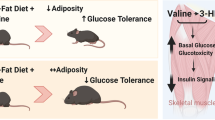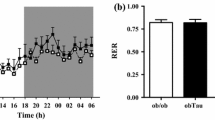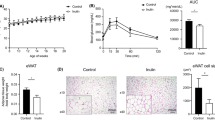Abstract
Various amino acid (AA) metabolites are used as supplements to facilitate metabolic control and enhance responsiveness of insulin-sensitive tissues. β-hydroxy-β-methylbutyrate (HMB) is a leucine metabolite proposed to prevent muscle wasting and to mitigate insulin resistance. Taurine, commonly added to energizing drinks, is a metabolite of methionine and cysteine present in bile juice, and proposed to be involved in lipid digestion and to be pro-lipolytic in adipocytes. N-methyltyramine (NMT) is a phenylalanine metabolite found in orange juices at 0.1–3 ppm while its effects on lipid mobilization remain controversial. Here, the putative lipolytic effects of these AA metabolites were studied and it was tested whether they could enhance insulin antilipolytic response in adipocytes. Release of glycerol and non-esterified fatty acids (NEFAs) was measured after a 2-h incubation of adipocytes obtained from control and diet-induced obese mice or from obese patients. In mouse, none of the tested AA derivatives was lipolytic from 1 μM to 1 mM. These compounds did not improve insulin antilipolytic effect or isoprenaline lipolytic action, except for 1 mM NMT that impaired triacylglycerol breakdown in obese mice. In human adipocytes, HMB and taurine were not lipolytic, while NMT weakly activated glycerol and NEFA release at 1 mM. However, 100 μM NMT impaired isoprenaline-stimulated lipolysis in a manner that was hardly added to insulin antilipolytic effect. Since none of these AA derivatives acutely helped or replaced insulin antilipolytic effect in adipocytes, the present in vitro observations do not support their proposed insulin-sensitizing properties. Moreover, NMT, HMB, and taurine were not notably lipolytic.





Similar content being viewed by others
References
Bruckbauer A, Zemel MB (2013) Synergistic effects of metformin, resveratrol, and hydroxymethylbutyrate on insulin sensitivity. Diabetes Metab Syndr Obes 6:93–102. https://doi.org/10.2147/dmso.s40840
Bruckbauer A, Zemel MB (2014) Synergistic effects of polyphenols and methylxanthines with leucine on AMPK/sirtuin-mediated metabolism in muscle cells and adipocytes. PLoS One 9:e89166. https://doi.org/10.1371/journal.pone.0089166
Bruckbauer A, Zemel MB, Thorpe T, Akula MR, Stuckey AC, Osborne D, Martin EB, Kennel S, Wall JS (2012) Synergistic effects of leucine and resveratrol on insulin sensitivity and fat metabolism in adipocytes and mice. Nutr Metab (Lond) 9:77. https://doi.org/10.1186/1743-7075-9-77
Carpéné C, Bousquet-Melou A, Galitzky J, Berlan M, Lafontan M (1998) Lipolytic effects of beta 1-, beta 2-, and beta 3-adrenergic agonists in white adipose tissue of mammals. Ann N Y Acad Sci 839:186–189
Carpéné C, Galitzky J, Fontana E, Atgié C, Lafontan M, Berlan M (1999) Selective activation of beta3-adrenoceptors by octopamine: comparative studies in mammalian fat cells. Naunyn Schmiedeberg's Arch Pharmacol 359:310–321
Carpéné MA, Testar X, Carpéné C (2014) High doses of synephrine and octopamine activate lipolysis in human adipocytes, indicating that amines from Citrus might influence adiposity. In: Hayat K (ed) Citrus, molecular phylogeny, antioxidant properties and medicinal uses. Nova Science Publishers Inc, New York, pp 141–168
Carpéné C, Garcia-Vicente S, Serrano M, Marti L, Belles C, Royo M, Galitzky J, Zorzano A, Testar X (2017) Insulin-mimetic compound hexaquis (benzylammonium) decavanadate is antilipolytic in human fat cells. World J Diabetes 8:143–153. https://doi.org/10.4239/wjd.v8.i4.143
Carpéné C, Galitzky J, Belles C, Zakaroff-Girard A (2018) Mechanisms of the antilipolytic response of human adipocytes to tyramine, a trace amine present in food. J Physiol Biochem 74:623–633. https://doi.org/10.1007/s13105-018-0643-z
Colivicchi MA, Raimondi L, Bianchi L, Tipton KF, Pirisino R, Della Corte L (2004) Taurine prevents streptozotocin impairment of hormone-stimulated glucose uptake in rat adipocytes. Eur J Pharmacol 495:209–215. https://doi.org/10.1016/j.ejphar.2004.05.004
De Carvalho FG, Barbieri RA, Carvalho MB, Dato CC, Campos EZ, Gobbi RB, Papoti M, Silva ASR, de Freitas EC (2018) Taurine supplementation can increase lipolysis and affect the contribution of energy systems during front crawl maximal effort. Amino Acids 50:189–198. https://doi.org/10.1007/s00726-017-2505-3
Decaunes P, Bouloumié A, Ryden M, Galitzky J (2018) Ex vivo analysis of lipolysis in human subcutaneous adipose tissue explants. Bio-protocol 8:e2711. https://doi.org/10.21769/BioProtoc.2711
Duan Y, Li F, Li Y, Tang Y, Kong X, Feng Z, Anthony TG, Watford M, Hou Y, Wu G, Yin Y (2016) The role of leucine and its metabolites in protein and energy metabolism. Amino Acids 48:41–51. https://doi.org/10.1007/s00726-015-2067-1
Duan Y, Zhang L, Li F, Guo Q, Long C, Yin Y, Kong X, Peng M, Wang W (2018) Beta-hydroxy-beta-methylbutyrate modulates lipid metabolism in adipose tissues of growing pigs. Food Funct 9:4836–4846. https://doi.org/10.1039/c8fo00898a
Elshorbagy AK, Kozich V, Smith AD, Refsum H (2012) Cysteine and obesity: consistency of the evidence across epidemiologic, animal and cellular studies. Curr Opin Clin Nutr Metab Care 15:49–57. https://doi.org/10.1097/MCO.0b013e32834d199f
Gannon NP, Schnuck JK, Vaughan RA (2018) BCAA metabolism and insulin sensitivity - dysregulated by metabolic status? Mol Nutr Food Res 62:e1700756. https://doi.org/10.1002/mnfr.201700756
Gomez-Zorita S, Belles C, Briot A, Fernandez-Quintela A, Portillo MP, Carpéné C (2017) Pterostilbene inhibits lipogenic activity similar to resveratrol or caffeine but differently modulates lipolysis in adipocytes. Phytother Res 31:1273–1282. https://doi.org/10.1002/ptr.5852
Green CR, Wallace M, Divakaruni AS, Phillips SA, Murphy AN, Ciaraldi TP, Metallo CM (2016) Branched-chain amino acid catabolism fuels adipocyte differentiation and lipogenesis. Nat Chem Biol 12:15–21. https://doi.org/10.1038/nchembio.1961
Kaneko H, Kobayashi M, Mizunoe Y, Yoshida M, Yasukawa H, Hoshino S, Itagawa R, Furuichi T, Okita N, Sudo Y, Imae M, Higami Y (2018) Taurine is an amino acid with the ability to activate autophagy in adipocytes. Amino Acids 50:527–535. https://doi.org/10.1007/s00726-018-2550-6
Kim HJ, Kwak B-M, Ahn J-H, Park J-S (2014) Simultaneous determination of synephrine and N-methyltyramine in orange fruit and juice from Korean market by UPLC-FLD. Korean J Food Sci Technol 46:276–282. https://doi.org/10.9721/KJFST.2014.46.3.276
Kim KS, Jang MJ, Fang S, Yoon SG, Kim IY, Seong JK, Yang HI, Hahm DH (2018) Anti-obesity effect of taurine through inhibition of adipogenesis in white fat tissue but not in brown fat tissue in a high-fat diet-induced obese mouse model. Amino Acids 51:245–254. https://doi.org/10.1007/s00726-018-2659-7
Koda H, Yokoo Y, Matsumoto N, Suwa Y, Fukazawa H, Ishida H, Tsuji K, Nukaya H, Kuriyama K (1999) Antagonistic effect of N-methyltyramine on alpha2-adrenoceptor in mice. Jpn J Pharmacol 81:313–315
Lafontan M, Berlan M (1995) Fat cell alpha 2-adrenoceptors: the regulation of fat cell function and lipolysis. Endocr Rev 16:716–738. https://doi.org/10.1210/edrv-16-6-716
Lynch CJ, Adams SH (2014) Branched-chain amino acids in metabolic signalling and insulin resistance. Nat Rev Endocrinol 10:723–736. https://doi.org/10.1038/nrendo.2014.171
Mercader J, Wanecq E, Chen J, Carpéné C (2011) Isopropylnorsynephrine is a stronger lipolytic agent in human adipocytes than synephrine and other amines present in Citrus aurantium. J Physiol Biochem 67:443–452. https://doi.org/10.1007/s13105-011-0078-2
Morin N, Lizcano JM, Fontana E, Marti L, Smih F, Rouet P, Prévot D, Zorzano A, Unzeta M, Carpéné C (2001) Semicarbazide-sensitive amine oxidase substrates stimulate glucose transport and inhibit lipolysis in human adipocytes. J Pharmacol Exp Ther 297:563–572
Nakaya Y, Minami A, Harada N, Sakamoto S, Niwa Y, Ohnaka M (2000) Taurine improves insulin sensitivity in the Otsuka Long-Evans Tokushima fatty rat, a model of spontaneous type 2 diabetes. Am J Clin Nutr 71:54–58. https://doi.org/10.1093/ajcn/71.1.54
Pina-Zentella G, de la Rosa-Cuevas G, Vazquez-Meza H, Pina E, de Pina MZ (2012) Taurine in adipocytes prevents insulin-mediated H2O2 generation and activates Pka and lipolysis. Amino Acids 42:1927–1935. https://doi.org/10.1007/s00726-011-0919-x
Rebourcet MC, Carpéné C, Lavau M (1988) Evidence of functional alpha 2-adrenergic receptors in adult-rat adipocytes by using the agonist UK 14304. Biochem J 252:679–682
Rossi AP, D’Introno A, Rubele S, Caliari C, Gattazzo S, Zoico E, Mazzali G, Fantin F, Zamboni M (2017) The potential of beta-hydroxy-beta-methylbutyrate as a new strategy for the management of sarcopenia and sarcopenic obesity. Drugs Aging 34:833–840. https://doi.org/10.1007/s40266-017-0496-0
Schnuck JK, Johnson MA, Gould LM, Gannon NP, Vaughan RA (2016) Acute beta-hydroxy-beta-methyl butyrate suppresses regulators of mitochondrial biogenesis and lipid oxidation while increasing lipid content in myotubes. Lipids 51:1127–1136. https://doi.org/10.1007/s11745-016-4193-2
Schnuck JK, Sunderland KL, Gannon NP, Kuennen MR, Vaughan RA (2016) Leucine stimulates PPARbeta/delta-dependent mitochondrial biogenesis and oxidative metabolism with enhanced GLUT4 content and glucose uptake in myotubes. Biochimie 128-129:1–7. https://doi.org/10.1016/j.biochi.2016.06.009
Stohs SJ, Hartman MJ (2015) A review of the receptor binding and pharmacological effects of N-methyltyramine. Phytother Res 29:14–16. https://doi.org/10.1002/ptr.5231
Ueki I, Stipanuk MH (2009) 3T3-L1 adipocytes and rat adipose tissue have a high capacity for taurine synthesis by the cysteine dioxygenase/cysteinesulfinate decarboxylase and cysteamine dioxygenase pathways. J Nutr 139:207–214. https://doi.org/10.3945/jn.108.099085
Wanders D, Graff EC, Judd RL (2012) Effects of high fat diet on GPR109A and GPR81 gene expression. Biochem Biophys Res Commun 425:278–283. https://doi.org/10.1016/j.bbrc.2012.07.082
Yonamine CY, Teixeira SS, Campello RS, Gerlinger-Romero F, Rodrigues CF Jr, Guimaraes-Ferreira L, Machado UF, Nunes MT (2014) Beta hydroxy beta methylbutyrate supplementation impairs peripheral insulin sensitivity in healthy sedentary Wistar rats. Acta Physiol (Oxford) 212:62–74. https://doi.org/10.1111/apha.12336
Zhang F, Zhao S, Yan W, Xia Y, Chen X, Wang W, Zhang J, Gao C, Peng C, Yan F, Zhao H, Lian K, Lee Y, Zhang L, Lau WB, Ma X, Tao L (2016) Branched chain amino acids cause liver injury in obese/diabetic mice by promoting adipocyte lipolysis and inhibiting hepatic autophagy. EBioMedicine 13:157–167. https://doi.org/10.1016/j.ebiom.2016.10.013
Acknowledgements
The authors are grateful to all the other participants of the HEPATIC/Refbio2 project and to the members of CTPIOD mini-network (http://obesitydiabetesinctp.weebly.com) for helpful discussions. All our thanks to Dr. Jean Galitzky, to Jean Jérôme Soueix (I2MC, Toulouse, France), and to Pr. Jean Louis Grolleau (Chirurgie plastique et des brulés, CHU Rangueil, Toulouse, France) for facilitating access to laboratory devices, networking, and to human surgical pieces, respectively.
Funding
This study was partly supported by recurrent INSERM funds and by FEDER funding via grants of the French-Spanish HEPATIC/Refbio2 project.
Author information
Authors and Affiliations
Corresponding author
Ethics declarations
All animal procedures complied with the principles established by the Institut National de la Santé et de la Recherche Médicale (INSERM, France) according to the Protocol Permission Number 12-1048-03-15 (on the 20/03/2012) and were approved by the local Ethics Committee of US006 CREFRE (Centre Régional d’Exploration Fonctionnelle et Ressources Expérimentales, Toulouse, France). All individuals gave their informed consent for their participation to the study as validated by the local ethic committee for the protection of individuals under the reference Comité de Protection des Personnes Sud Ouest et Outre Mer II, DC-2008-452.
Conflict of interest
The authors declare that they have no conflict of interest.
Additional information
Publisher’s note
Springer Nature remains neutral with regard to jurisdictional claims in published maps and institutional affiliations.
Rights and permissions
About this article
Cite this article
Leroux, M., Lemery, T., Boulet, N. et al. Effects of the amino acid derivatives, β-hydroxy-β-methylbutyrate, taurine, and N-methyltyramine, on triacylglycerol breakdown in fat cells. J Physiol Biochem 75, 263–273 (2019). https://doi.org/10.1007/s13105-019-00677-5
Received:
Accepted:
Published:
Issue Date:
DOI: https://doi.org/10.1007/s13105-019-00677-5




